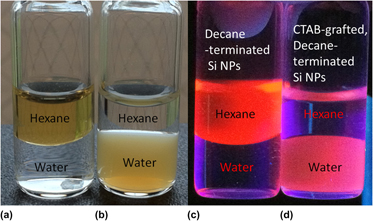Crossref Citations
This article has been cited by the following publications. This list is generated based on data provided by
Crossref.
Wong, Keith T.
Shong, Bonggeun
Sun, Weikang
and
Bent, Stacey F.
2013.
Adsorption of Trimethyl Phosphite at the Ge(100)-2 × 1 Surface by Nucleophilic Reaction.
The Journal of Physical Chemistry C,
Vol. 117,
Issue. 50,
p.
26628.
Kumaran, Rangarajulu
Choi, Yong-Keun
Singh, Vijay
Song, Hak-Jin
Song, Kyung-Guen
Kim, Kwang
and
Kim, Hyung
2015.
In Vitro Cytotoxic Evaluation of MgO Nanoparticles and Their Effect on the Expression of ROS Genes.
International Journal of Molecular Sciences,
Vol. 16,
Issue. 4,
p.
7551.
Hwang, Jangsun
Jeong, Yoon
Lee, Kwan Hong
Seo, Youngmin
Kim, Jieun
Hong, Jong Wook
Kamaloo, Elaheh
Camesano, Terri A.
and
Choi, Jonghoon
2015.
Simple Preparation of Fluorescent Silicon Nanoparticles from Used Si Wafers.
Industrial & Engineering Chemistry Research,
Vol. 54,
Issue. 22,
p.
5982.
DeBenedetti, William J. I.
Chiu, Sheng-Kuei
Radlinger, Christine M.
Ellison, Rylie J.
Manhat, Beth A.
Zhang, Jin Z.
Shi, Jianying
and
Goforth, Andrea M.
2015.
Conversion from Red to Blue Photoluminescence in Alcohol Dispersions of Alkyl-Capped Silicon Nanoparticles: Insight into the Origins of Visible Photoluminescence in Colloidal Nanocrystalline Silicon.
The Journal of Physical Chemistry C,
Vol. 119,
Issue. 17,
p.
9595.
Montalti, M.
Cantelli, A.
and
Battistelli, G.
2015.
Nanodiamonds and silicon quantum dots: ultrastable and biocompatible luminescent nanoprobes for long-term bioimaging.
Chemical Society Reviews,
Vol. 44,
Issue. 14,
p.
4853.
Kislitsyn, Dmitry A.
Kocevski, Vancho
Mills, Jon M.
Chiu, Sheng-Kuei
Gervasi, Christian F.
Taber, Benjamen N.
Rosenfield, Ariel E.
Eriksson, Olle
Rusz, Ján
Goforth, Andrea M.
and
Nazin, George V.
2016.
Mapping of Defects in Individual Silicon Nanocrystals Using Real-Space Spectroscopy.
The Journal of Physical Chemistry Letters,
Vol. 7,
Issue. 6,
p.
1047.
Mazzaro, Raffaello
Romano, Francesco
and
Ceroni, Paola
2017.
Long-lived luminescence of silicon nanocrystals: from principles to applications.
Phys. Chem. Chem. Phys.,
Vol. 19,
Issue. 39,
p.
26507.
Jettanasen, J.
Preecha, P.
Kunakonrangsiman, I.
Karpkird, T.
and
Limtrakul, J.
2017.
Study of Colloidal Suspensions of Silicon Nanoparticles: Effect of Surface Oxidation on the Photoluminescence Property.
International Journal of Nanoscience,
Vol. 16,
Issue. 05n06,
p.
1750011.
Robidillo, Christopher Jay T.
Aghajamali, Maryam
Faramus, Angelique
Sinelnikov, Regina
and
Veinot, Jonathan G. C.
2018.
Interfacing enzymes with silicon nanocrystals through the thiol–ene reaction.
Nanoscale,
Vol. 10,
Issue. 39,
p.
18706.
Kislitsyn, Dmitry A.
Mills, Jon M.
Chiu, Sheng-Kuei
Taber, Benjamen N.
Barnes, James D.
Gervasi, Christian F.
Goforth, Andrea M.
and
Nazin, George V.
2018.
Creation and Annihilation of Charge Traps in Silicon Nanocrystals: Experimental Visualization and Spectroscopy.
The Journal of Physical Chemistry Letters,
Vol. 9,
Issue. 4,
p.
710.
Li, Yanjuan
Li, Wei
Zhang, Haoran
Dong, Riyue
Li, Dongna
Liu, Yingliang
Huang, Ling
and
Lei, Bingfu
2019.
Biomimetic preparation of silicon quantum dots and their phytophysiology effect on cucumber seedlings.
Journal of Materials Chemistry B,
Vol. 7,
Issue. 7,
p.
1107.
Canham, Leigh
2020.
Introductory lecture: origins and applications of efficient visible photoluminescence from silicon-based nanostructures.
Faraday Discussions,
Vol. 222,
Issue. ,
p.
10.
Mohammadpour, Z.
and
Molaabasi, F.
2023.
Quantum Dots in Bioanalytical Chemistry and Medicine.
p.
175.
Li, Jing
Li, Xiaona
Kah, Melanie
Yue, Le
Cheng, Bingxu
Wang, Chuanxi
Wang, Zhenyu
and
Xing, Baoshan
2024.
Unlocking the potential of carbon dots in agriculture using data-driven approaches.
Science of The Total Environment,
Vol. 944,
Issue. ,
p.
173605.
He, Yizhou
Hao, Qianxi
Zhang, Chi
Wang, Qi
Zeng, Wenxin
Yu, Jiamin
Yang, Xue
Li, Shaorong
Guo, Xiaowei
and
Lazarouk, Serguei K.
2025.
Facile synthesis of silicon quantum dots with photoluminescence in the near-ultraviolet to violet region via wet oxidation.
Journal of Materials Chemistry C,
Vol. 13,
Issue. 3,
p.
1228.



